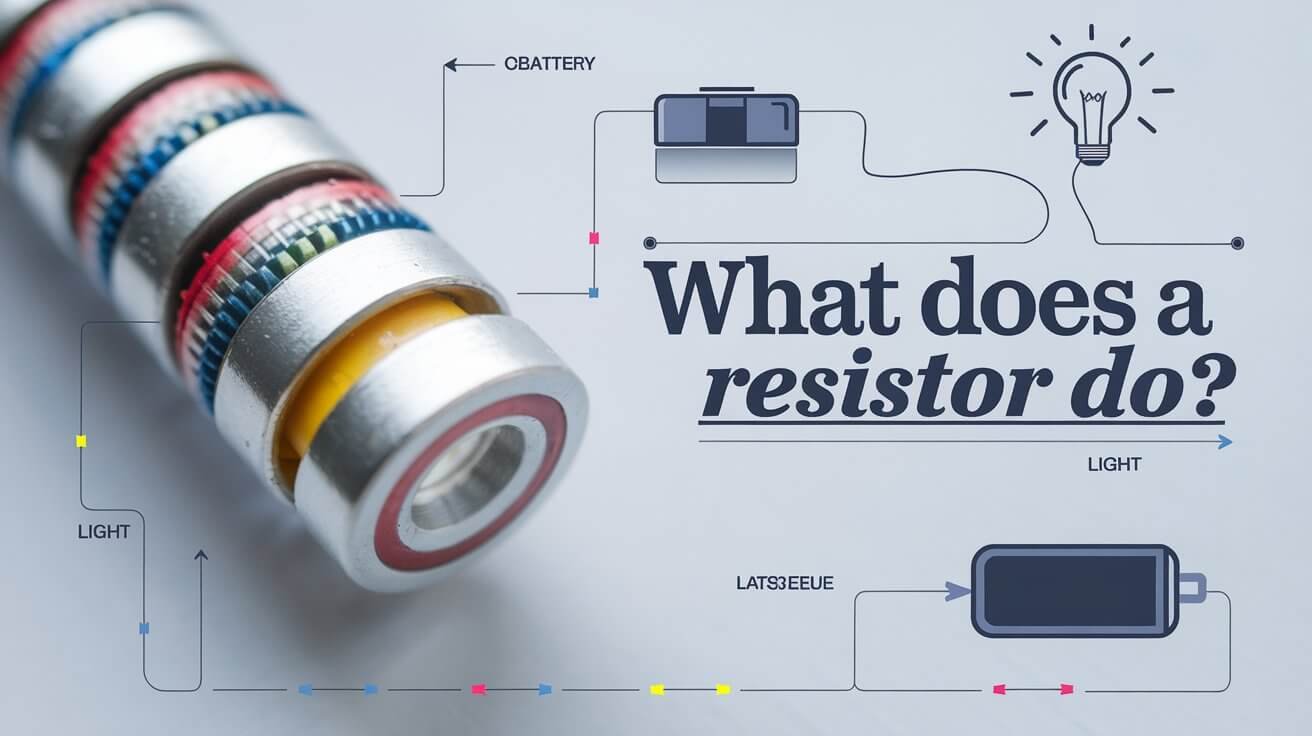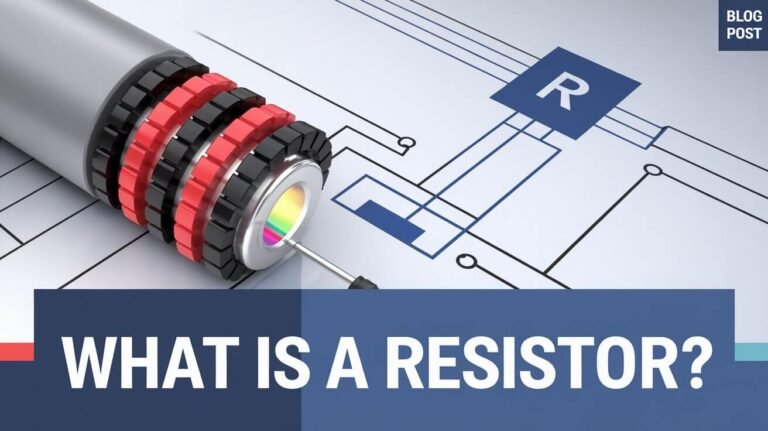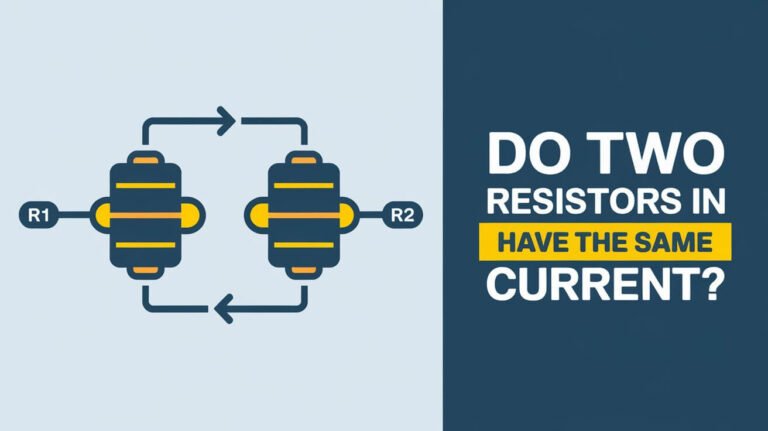
A resistor is a key part of electronic circuits. It helps control the flow of electrical current. This is important for designing and building electronic devices.
Resistors don’t do anything on their own. But, they are very important. They make sure other parts of the circuit get the right amount of voltage and current.
Resistors mainly create a voltage drop. This protects sensitive parts from too much voltage. This is very important in electronic circuits.
They help control the brightness of LEDs and create time delays. They also change sensor data into voltage. Knowing how resistors work is key in electronics. They often work with other parts like relays and capacitors to do specific tasks in a circuit.
Core Functions of Resistors in Electronic Circuits
Resistors are key in electronic circuits. They control current flow, divide voltage, and manage heat. In a circuit, resistors cut down the current. This is vital to avoid damage and ensure everything works right.
Resistors control current because of their material. The resistance value of a resistor decides how much current it can handle. This makes resistors important for voltage division and heat dissipation. They help reduce voltage levels in circuits, which is essential for many designs.
Key Functions of Resistors
- Current control: Resistors regulate the flow of electrons, preventing excessive current from damaging components.
- Voltage division: Resistors reduce voltage levels in circuits, allowing designers to create circuits with specific voltage requirements.
- Heat dissipation: Resistors convert electrical energy into thermal energy, which can be desirable in some applications, such as heating appliances, but also requires careful management to prevent overheating.
Resistors are essential in electronic circuits. They control current, divide voltage, and manage heat. These functions are vital for many applications, from simple circuits to complex systems.
| Resistor Function | Description |
|---|---|
| Current Control | Regulates the flow of electrons to prevent excessive current |
| Voltage Division | Reduces voltage levels in circuits to meet specific requirements |
| Heat Dissipation | Converts electrical energy into thermal energy, requiring careful management |
Physical Structure of Resistors
Resistors are made from different materials like carbon, metallic film, and wire-wound. The material used affects how well the resistor works. For example, wire-wound resistors are made by wrapping wire around a core. Carbon resistors are a mix of carbon and ceramic.
The way a resistor is built also matters. Each material has its own strengths and weaknesses. Carbon resistors are cheap but only work well in certain temperatures. Wire-wound resistors can handle high temperatures but cost more.
Some key things about resistors include:
- Resistance values: Resistors can have a wide range of resistance values.
- Power rating: Most resistors in electronic systems are 1/10 to 1/4 watt.
- Temperature coefficient: This is important in precise applications, usually given as a value in parts per million per degree centigrade (or Kelvin).
In short, knowing about resistor materials and construction is key to picking the right one. By looking at the characteristics of different resistors, designers can make better electronic circuits.
| Resistor Type | Materials | Advantages | Disadvantages |
|---|---|---|---|
| Carbon Resistor | Carbon and ceramic | Inexpensive, compact | Limited temperature range |
| Wire-Wound Resistor | Metal wire and core | High temperature range, high power rating | Expensive, large size |
| Metallic Film Resistor | Metal film and ceramic | High precision, low noise | Higher cost, limited power rating |
Types of Resistors and Their Applications
Resistors are key in electronic circuits. They come in different types for various uses. Fixed resistors stay mostly the same, changing a bit with temperature or voltage. This makes them reliable in most circuits.
Variable resistors, like potentiometers, can be adjusted. They’re used in volume controls and light dimmers. Special resistors, like thermistors, sense temperature or light, used in specific tasks.
Characteristics of Fixed, Variable, and Special Resistors
Fixed resistors are common because they’re stable and affordable. Variable resistors are needed where you can adjust settings, like in audio gear. Special resistors, like thermistors, are sensitive to temperature or light.
Some common types of resistors include:
- Wire-wound resistors, used for high power and accuracy
- Metal film resistors, great for precision in audio and measuring tools
- Carbon composition resistors, good for handling high energy pulses
Choosing the right resistor depends on the circuit’s needs. Knowing about fixed, variable, and special resistors helps designers pick the best one. This ensures their circuits work well and reliably.
What Does A Resistor Do in Common Circuit Designs
Resistors are key in many circuit designs. They help control voltage and current. They are used to set LED brightness, add delays with capacitors, and change sensor signals into voltage.
Resistors protect against voltage spikes and create voltage drops. They ensure the right voltage is received. For instance, they prevent LED damage from too much current. They also manage volume in audio gear and voltage in power supplies.
Resistors are used in many circuit designs, including:
- LED circuits: to control brightness and prevent damage from high electrical current
- Audio equipment: to control volume levels and regulate output voltage
- Power supplies: to regulate output voltage and ensure proper voltage reception
- Sensor circuits: to convert sensor values into usable voltage signals
The right resistor is chosen based on the circuit’s needs. There are many types of resistors, each with its own benefits and drawbacks. Knowing how resistors work helps designers make better circuits.
Color Code System for Resistor Values
Resistors come in a wide range of values, from milliohms to megohms. A color code system helps quickly identify these values. The 4-band color code is the most common. It shows the first two digits of resistance, the number of zeros, and the tolerance in the fourth band.
The tolerance is shown by the fourth band. Different colors mean different tolerances. For instance, brown is 1% and red is 2%. The power rating is also key, as it shows the maximum power a resistor can handle.
Reading Color Bands
To read resistor color bands, start with the first two bands. They show the first two digits of resistance. The third band tells you how many zeros to add. The fourth band shows the tolerance.
Tolerance Indicators
The fourth band indicates the resistor’s tolerance. Here’s a table of common tolerance indicators:
| Color | Tolerance |
|---|---|
| Brown | 1% |
| Red | 2% |
| Gold | 5% |
| Silver | 10% |
Power Rating Markings
When picking a resistor, choose one with twice the power rating you need. This makes sure the resistor can handle the circuit’s maximum power.
Circuit Protection Through Resistors
Resistors are key in protecting electronic parts and circuits. They limit current flow to prevent damage. This is vital when voltage spikes can harm components.
Resistors also help regulate voltage for components. This is important when components need a specific voltage to work right. A resistor can lower the voltage, protecting against overvoltage damage.
Some common types of resistors for protection include:
- Fusible resistors, which act like fuses and burn out with too much current
- Wirewound resistors, great for high power and used in power electronics and industry
- Thin film resistors, precise and stable, good for precise instruments and medical devices
Choosing the right resistor is key for circuit protection. Look at resistance value, tolerance, power rating, and temperature coefficient. The right resistor ensures your circuit works safely and reliably. Resistors are not just random parts; they’re vital for protecting against overcurrent and overvoltage.
| Resistor Type | Characteristics | Applications |
|---|---|---|
| Fusible Resistors | Act as fuses, burn out when subjected to excessive current | Circuit protection, overcurrent protection |
| Wirewound Resistors | High power handling, high precision | Power electronics, industrial applications, motor controls |
| Thin Film Resistors | High precision, low temperature coefficients | Precision instruments, medical devices, aerospace applications |
Resistor Calculations and Ohm’s Law
Understanding resistor calculations is key. Ohm’s law shows that voltage is directly related to current through a resistor. This law helps us figure out voltage, current, and resistance in circuits.
In resistor networks, Ohm’s law helps us find total resistance, voltage, and current. For series circuits, total resistance is the sum of each resistor. We use P = I^2R to find power dissipated by each resistor.
Basic Resistance Formulas
The total resistance in series circuits is the sum of all resistances: Rs = R1 + R2 + R3 + … . Parallel circuits use 1/Rp = 1/R1 + 1/R2 + 1/R3 + … to find equivalent resistance.
Power Dissipation Mathematics
Power dissipated by a resistor is voltage times current. In series circuits, total power is the source’s power output. For example, with 20.0 Ω total resistance and 0.60 A current, we find power for each resistor and sum them.
Series and Parallel Configurations
Resistors can be in series or parallel. Series circuits have the same current through each resistor. Parallel circuits have the same voltage across each resistor. Knowing these is key for designing and analyzing resistor networks.
| Circuit Type | Total Resistance | Current | Voltage |
|---|---|---|---|
| Series | Rs = R1 + R2 + R3 + … | I = V / Rs | V = IR |
| Parallel | 1/Rp = 1/R1 + 1/R2 + 1/R3 + … | I = V(1/R1 + 1/R2 + 1/R3) | V = IRp |
Using Ohm’s law and understanding resistor networks, designers can make efficient circuits. Whether it’s series or parallel, accurate calculations are vital for circuit success.
Troubleshooting Resistor-Related Issues
Working with electronic circuits often means dealing with resistor failure. It’s key to spot the signs of this issue to fix circuits well. Look out for burn marks or discoloration on resistors and odd circuit behavior like wrong voltage readings.
To solve resistor problems, knowing their role is vital. Resistors control current flow, split voltage, and protect other parts. They can fail if they get too hot, which happens when they handle too much power. Choose the right resistor for your circuit, considering its value, power rating, and tolerance.
Resistor burnout can be caused by a few things:
- High voltage
- Too much electricity
- Getting too hot
Knowing these causes helps you avoid resistor failure. This keeps your circuit running smoothly.
| Resistor Type | Common Applications | Potential Failure Causes |
|---|---|---|
| Fixed Resistors | Voltage division, current limiting | Overheating, excess voltage |
| Variable Resistors | Volume control, signal processing | Wear and tear, poor contact |
Following these tips, you can get better at fixing circuits. This ensures your electronic projects work well.
Real-World Applications of Resistors
Resistors are key in electrical circuits, helping current flow. They are used in many ways like controlling current, regulating signals, and dividing voltages. You’ll find resistors in heaters, light bulbs, laptops, and cell phones, among others.
In specific applications, resistors are very important. For example, in
LED Circuit Applications
, resistors control current and prevent damage. This is key for LEDs to work well and last long. In
Audio Equipment Usage
, resistors adjust current or voltage in circuits. This is seen in volume controls and audio filters. Also, in
Power Supply Implementation
, resistors regulate voltage and limit current. They are essential in power supplies.
Some examples of resistor applications include:
- LED circuits: resistors control current and prevent damage.
- Audio equipment: resistors adjust current or voltage in circuits, like volume controls and audio filters.
- Power supplies: resistors regulate voltage and limit current, vital in power supplies, including LED circuits and audio applications.
Resistors are everywhere in electronic devices. They are vital for keeping devices stable and working right. By knowing how resistors work, we see their big role in our daily lives.
In Conclusion
Resistors are key in electronic design. They control current flow and divide voltages. They are essential in many circuits.
Whether you’re making LED lights, audio gear, or power systems, knowing about resistor importance is vital. It helps you master electronic design.
Resistors might seem simple, but they’re very important. They help control current and are vital for timing. They are true unsung heroes of electronics.
As you explore electronics, remember what you’ve learned about resistors. They are a solid base for your future projects and ideas.
User Questions
What is the primary function of a resistor in electronic circuits?
A resistor’s main job is to slow down the flow of electric current. They are key in making sure devices work right and stay safe. This is because they control how much current flows.
What are the three core functions of resistors in electronic circuits?
Resistors have three main jobs. They control the current, split the voltage, and turn electrical energy into heat.
What materials are typically used in the construction of resistors?
Resistors are made from materials like carbon, metal films, and wire. The material used changes how well the resistor works. It affects its value, how accurate it is, and how much power it can handle.
What are the main types of resistors and their common applications?
There are three main types of resistors. Fixed resistors are used in most circuits because they stay the same. Variable resistors, like potentiometers, can be adjusted. Special resistors, like thermistors, change with temperature or light.
How are resistors used in common electronic circuit designs?
Resistors are vital in many circuits. They help control LED lights, make timing circuits with capacitors, and change sensor signals into voltage.
How do you read the color code system used to denote resistor values?
The color code on resistors shows its value, how accurate it is, and its power rating. By reading these colors, you can figure out what the resistor is.
How do resistors help protect electronic components and circuits?
Resistors protect circuits by limiting current and dropping voltage. This keeps sensitive parts safe from damage and overvoltage.
What are the fundamental calculations involved in working with resistors?
Working with resistors involves using Ohm’s Law, figuring out power dissipation, and looking at series and parallel circuits.
How can you troubleshoot issues related to resistors in electronic circuits?
To fix resistor problems, look for signs of damage or odd behavior. Then, follow steps to find and fix the issue.
Where are resistors commonly used in real-world electronic devices?
Resistors are found in many devices. They help LEDs work right, control audio in equipment, and regulate voltage in power supplies.




